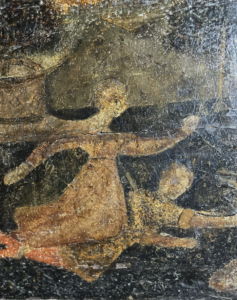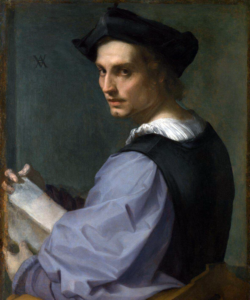St. Michael the Archangel Overcoming Satan
Giovanni Andrea Sirani
Below the image, click play to listen.
Walnut and pastiglia
Italian, 15th century
The antique furnishings in the Museum & Gallery collection elevate each visitor’s experience of the artwork on the walls, but the pieces also provide a historical context of the eras and cultures from which the artworks sprang. Indeed, the furnishings are also artworks in themselves.
This is certainly true of the many cassoni (plural of the Italian term for “chests”) in the collection. Like other furnishings in Renaissance homes, the quality of workmanship and materials employed in decorating each cassone convey a great deal about the fashion of their times, the technologies available to craftsmen, and the wealth and social status of their owners.
Unfortunately, much has gone against their survival to our day. Cassoni were used for storage of personal items, opened and closed numerous times over the years. That wear, along with the environment in a home, infestations of termites, dry rot, changes in taste and reversals of family fortunes all conspire against the preservation of these furnishings.
These rich, showy Italian types of chests became widespread in Northern and Central Italy, particularly Tuscany (with a number of the best artists hailing from the cities of Siena and Florence). Weddings served as the occasions for which cassoni were made, and they were in fashion from the 14th-16th centuries, a period spanning the very late-Middle Ages to the beginning and middle of the Renaissance. The oldest surviving cassoni feature primitive panel designs, while later works demonstrate lavish carving, gilding, polychrome, and more complex narrative scenes.
Much like moving trucks, boxes, and barrels accompanying the establishment of new homes, cassoni had a very specific use. Practically speaking, the chests were designed to contain the bride’s dowry and jewels, her family’s contribution to the marriage, and became one of the couple’s most important household furnishings—often at the foot of the bed. They quite literally became a vehicle displaying the status, wealth and sophistication of the intermarrying families, carried in a procession (the domum ductio) from the bride’s parent’s home to her groom’s abode.
Decoratively speaking, cassoni often feature heraldic imagery relating to the families’ crests, and the pictorial panels often contained biblical, mythological, or allegorical imagery which ranged from learned and literary to humorous and light-hearted. Cassoni themselves were so common in the early- and middle-Renaissance that they’re included in Old Master paintings (most familiar may be scenes of the Annunciation in which Mary is seated on or kneeling near a cassone situated at the foot of her curtained bed) and even picture-within-picture vignettes on cassoni panels themselves.
This particular M&G cassone entered the collection in 1957, and its features suggest a date very early after 1400, likely from Tuscany. Unlike many cassoni today, which have the panels removed and presented as separate works of art in their own right, our chest is in good original condition and is structurally sound, despite surviving 600 years of use and change. The lid is still attached with its original hinges and has a simple locking mechanism. While the lid opens and closes easily, the tight fit and years of use have worn off some of the gesso along the top edge.
Composed of thick walnut planks and framing, the chest has a large front center panel decorated with gilt and polychrome over trellis-embossed gesso. Heraldic lions (possibly leopards or even hunting dogs) face each other across the front, and the two vertical end panels blossom with delicate arabesques and outline colored shields, which likely contained familial coats of arms.
 Carved, fluted pilasters frame the two pictorial end panels and are topped with vague Corinthian capitals. The primitive-style narrative at the right end is now entirely obscured, but the imagery at the opposite end remains. The subject matter is indistinct and may be biblical or mythological. Most likely, perhaps, it is the myth of Diana (Artemis) and Actaeon, from Ovid’s Metamorphoses, in which the bathing goddess is startled by a young hunter. In her anger, Diana turns Actaeon into a stag who is then hunted and killed by his own hounds. This identification seems to make sense of the simplistic representation of forest, pool, a stag’s head (lower right) and a hound in the left background. As an allegory or fable for a young couple, it may emphasize modesty, self control, and consequences for the lack of either or both.
Carved, fluted pilasters frame the two pictorial end panels and are topped with vague Corinthian capitals. The primitive-style narrative at the right end is now entirely obscured, but the imagery at the opposite end remains. The subject matter is indistinct and may be biblical or mythological. Most likely, perhaps, it is the myth of Diana (Artemis) and Actaeon, from Ovid’s Metamorphoses, in which the bathing goddess is startled by a young hunter. In her anger, Diana turns Actaeon into a stag who is then hunted and killed by his own hounds. This identification seems to make sense of the simplistic representation of forest, pool, a stag’s head (lower right) and a hound in the left background. As an allegory or fable for a young couple, it may emphasize modesty, self control, and consequences for the lack of either or both.
This cassone provides insight into the artistry, fashion, and domestic life of those living in the early years of the Italian Renaissance and is a valuable part of the M&G collection.
Dr. Stephen B. Jones, M&G volunteer
Additional Resources:
The Oxford History of Western Art. Kemp, Martin, ed. Oxford University Press, 2000.
Pooley, Eugene. “Scenes from a Marriage.”
https://blog.dorotheum.com/en/classic-week-florentine-school/
https://www.medieval.eu/bridal-chests-or-cassoni-from-medieval-italy/
Published 2023
Oil on panel, c. 1529–30
Florentine, 1486–1530
Andrea d’Agnolo grew up in Florence and was nicknamed del Sarto meaning “of the tailor” after his father’s profession. Like other early Renaissance artists, he initially trained with a goldsmith, then studied under a series of three separate painters until he began producing his own works in 1506. He spent most of his life in Florence—except for a visit to Rome and a brief stint as court painter to King François I at Fontainebleau in 1518.
 As the son of a tailor, del Sarto’s works reveal a unique understanding and love of fabrics—even seen in his 1517-1518 Portrait of a Young Man in London’s National Gallery, which may be a self-portrait (on right). Notice the finishes of the puffed sleeve, ruched white undershirt, and the vest’s seam at the shoulder.
As the son of a tailor, del Sarto’s works reveal a unique understanding and love of fabrics—even seen in his 1517-1518 Portrait of a Young Man in London’s National Gallery, which may be a self-portrait (on right). Notice the finishes of the puffed sleeve, ruched white undershirt, and the vest’s seam at the shoulder.
Andrea was also influenced by his contemporaries who outlived him: Leonardo da Vinci, Michelangelo, and Raphael. Once these masters left Florence for other parts of Italy, Andrea became Florence’s leading artist in the early 1500s. He is overlooked in art history; yet he is equal in skill and quality to the three greats, and his works are beautiful and still revered today. Julian Brooks, curator of drawings at the Getty, recognizes del Sarto as the “revolutionary engine of the Renaissance and the transformer of draughtsmanship” due to his careful and creative preparatory drawings, a practice which inspired the next generations of artists to follow.
However, he has been underappreciated, even to the point of his students overshadowing him to become famous including Rosso Fiorentino, Jacopo da Pontormo, and Giorgio Vasari, biographer of contemporary Renaissance artists. Vasari records details about his teacher as related to M&G’s work. A Florentine charitable organization for plague victims, the Company of St. Sebastian commissioned Andrea del Sarto to paint a picture of St. Sebastian, the patron saint for plague victims. He became a member of the Company in February 1529, perhaps as a result of negotiations surrounding the commission. Ironically, shortly after completing the painting in 1530 during Florence’s plague epidemic, del Sarto died from the plague at 44 years old.
Several 17th-century documents list the original St. Sebastian as the property of the Company of St. Sebastian. Publications in 1759 and 1770 mention that the painting moved to the Pitti Palace in Florence. By the early 19th century, writers could no longer trace the location of the original painting—apparently it was removed from the Pitti Palace and lost.
M&G acquired St. Sebastian in 1970 from the former great British collection of the Cook family. In 2005, the National Gallery of Canada requested St. Sebastian to participate in an exhibition, and we sent our work in advance for study and conservation. The conservator Stephen Gritt found, “In its materials and construction, the painting is entirely consistent with one from Sarto’s workshop. The complete absence of any change in the design from the drawing stage on the panel through to the painting would indicate perhaps that the design had reached a point of satisfactory refinement by the time this version was produced. While this may mean that some artist other than Sarto could have painted the work, it does not exclude his participation in its production as a supervisor.”
Regarding del Sarto’s workshop practice, Julian Brooks notes that “Andrea would have been closely involved in the production of all versions, or at least those produced in his workshop during his lifetime, and these were produced side by side in the studio.” He also made, used, and reused partial cartoons.
It is difficult to confidently confirm if M&G’s St. Sebastian is the missing painting by the master, thus the current attribution, studio of Andrea del Sarto. At the least, someone very close to del Sarto painted the work. Found in Italy, Spain, England, and Austria, more than 10 other variants of the St. Sebastian exist. Even so, M&G’s is considered by specialists as the “best surviving reflection of the original.”
Erin R. Jones, Executive Director
Published 2023
Enjoy this series of segments highlighting Picture Books of the Past: Reading Old Master Paintings, a loan exhibition of 60+ works from the M&G collection. The exhibit has traveled to The Museum of the Bible in Washington, D. C. and the Orlando Museum of Art in Florida.
This work introduces one of Jesus’s most devoted followers, Mary Magdalene. Notice that her clothing is of silk and velvet, the rich fabrics of a prosperous woman. However, this imagery of prosperity is offset by the murky background and the presence of a skull. Her body position (which turns her away from death’s symbol) and her long, flowing hair (reminiscent of her repentance) shifts the narrative mood from one of despair to hope.